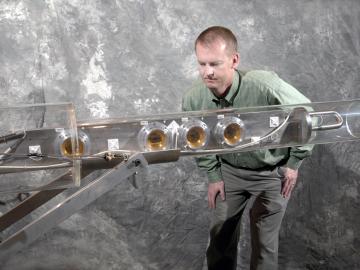
Filter News
Area of Research
- Advanced Manufacturing (3)
- Biological Systems (1)
- Biology and Environment (29)
- Computational Biology (2)
- Computational Engineering (1)
- Computer Science (3)
- Energy Science (62)
- Fusion and Fission (16)
- Fusion Energy (11)
- Isotopes (5)
- Materials (32)
- Materials for Computing (9)
- National Security (20)
- Neutron Science (79)
- Nuclear Science and Technology (11)
- Quantum information Science (1)
- Supercomputing (40)
- Transportation Systems (2)
News Type
News Topics
- (-) Big Data (62)
- (-) Biomedical (53)
- (-) Coronavirus (30)
- (-) Cybersecurity (17)
- (-) Fusion (47)
- (-) Mercury (10)
- (-) Neutron Science (109)
- (-) Security (17)
- (-) Transportation (66)
- 3-D Printing/Advanced Manufacturing (89)
- Advanced Reactors (25)
- Artificial Intelligence (92)
- Bioenergy (84)
- Biology (100)
- Biotechnology (28)
- Buildings (50)
- Chemical Sciences (48)
- Clean Water (30)
- Composites (21)
- Computer Science (153)
- Critical Materials (17)
- Education (2)
- Emergency (4)
- Energy Storage (64)
- Environment (164)
- Exascale Computing (52)
- Fossil Energy (7)
- Frontier (45)
- Grid (54)
- High-Performance Computing (93)
- Hydropower (12)
- Irradiation (2)
- Isotopes (38)
- ITER (7)
- Machine Learning (51)
- Materials (87)
- Materials Science (89)
- Mathematics (11)
- Microelectronics (3)
- Microscopy (34)
- Molten Salt (7)
- Nanotechnology (29)
- National Security (63)
- Nuclear Energy (85)
- Partnerships (37)
- Physics (38)
- Polymers (18)
- Quantum Computing (39)
- Quantum Science (59)
- Simulation (51)
- Software (1)
- Space Exploration (23)
- Statistics (3)
- Summit (48)
Media Contacts

From decoding plant genomes to modeling microbial behavior, computational biologist Priya Ranjan builds computational tools that turn extensive biological datasets into real-world insights. These tools transform the way scientists ask and answer complex biological questions that advance biotechnology breakthroughs and support cultivation of better crops for energy and food security.

Van Graves, an engineering manager at ORNL, is celebrating 40 years of dedicated service leading a diverse range of prominent engineering projects at ORNL and internationally.

As the focus on energy resiliency and competitiveness increases, the development of advanced materials for next-generation, commercial fusion reactors is gaining attention. A recent paper examines a promising candidate for these reactors: ultra-high-temperature ceramics, or UHTCs.

Using the Frontier supercomputer, a team of researchers from the Massachusetts Institute of Technology conducted large-scale calculations to chart the isospin density of a neutron star across a range of conditions. Their work provides new insights into how pressure and density interact within neutron stars, offering important predictions about their inner workings.

The Heartbeat Detector, developed at ORNL and licensed by Geovox Security Inc., detects hidden individuals in vehicles by measuring suspension vibrations. Now using a compact black box and cloud software, the system is more affordable and easier to use, while remaining the industry standard worldwide.

Jesse Labbé aims to leverage biology, computation and engineering to address societal challenges related to energy, national security and health, while enhancing U.S. competitiveness. Labbé emphasizes the importance of translating groundbreaking research into practical applications that have real-world impact.

Scientists at the Department of Energy’s Oak Ridge National Laboratory recently welcomed Vanderbilt University colleagues for a symposium on basic science research, with a focus on potential collaborations in the biomedical and biotechnology spaces.
Daniel Jacobson, distinguished research scientist in the Biosciences Division at ORNL, has been elected a Fellow of the American Institute for Medical and Biological Engineering, or AIMBE, for his achievements in computational biology.
Troy Carter, director of the Fusion Energy Division at Oak Ridge National Laboratory, leads efforts to make fusion energy a reality, overseeing key projects like MPEX and fostering public-private collaborations in fusion research.
Dave Weston studies how microorganisms influence plant health and stress tolerance, using the Advanced Plant Phenotyping Laboratory to accelerate research on plant-microbe interactions and develop resilient crops for advanced fuels, chemicals and


